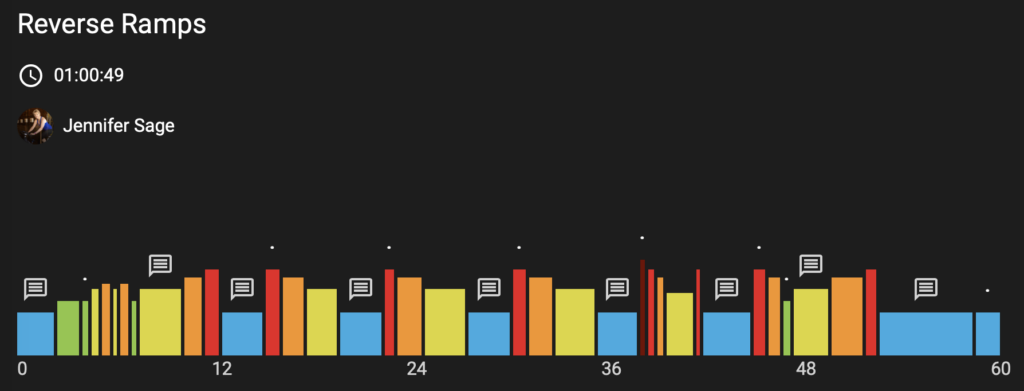After more than two and a half decades teaching indoor cycling classes, I still get excited about a brand-new profile I’ve created, and I’m even more thrilled when I get to share it with other instructors! This profile is no different—I hope you enjoy teaching it as much as I did and that your riders love it as much as mine did!
I’ve been doing ramp intervals, also known as ladders, since I first began teaching Spinning®. A ramp implies working at a lower intensity, usually beginning at a moderate effort, and gradually increasing the intensity so that the work progresses from moderate to hard to harder. As you progress in difficulty, for the most part the time spent at the higher levels is reduced.
One of the beauties of ramps is that there are so many ways to vary them.
I created a profile in the early days of ICA in 2011 called Ramp It Up (Through the Doors). These were what I later called “3-2-1 intervals,” and consisted of 3 minutes at a moderate intensity, 2 minutes hard, and 1 minute very hard, followed by a 2.5– to 3-minute recovery. “Through the Doors” referred to the fun fact that every recovery song in that profile was a song by The Doors, so you were essentially stepping through The Doors!
I created another ramp profile in 2017 called 3-2-1 Intervals. This new version, however, added another hurdle. Instead of having a recovery after each 6-minute interval, this time, the first two were followed by full recoveries, but the next two sets removed the recovery between two ramps. Those longer intervals progressed as 3-2-1-3-2-1, followed by a recovery, then 3-2-1-3-2-1.
That profile explained how to use this outline as a template to make your own ramp interval profiles; all that is needed is a large bucket playlist of 6-minute songs of varying tempos and genres to choose from.
This article in our Obsessed with Cycling Drills (OCD) series further describes a ramp drill and how to use it in any profile.
I later added a challenging twist to this ride by extending the time spent at each level, creating the 4-3-2 Interval profile.
In 2019, I created a further variation and titled it 3-2-1 Intervals…Intensified! As before, the efforts progressed from moderate to hard to harder, but the time spent at each level varied with each successive interval. The first interval was the familiar 3-2-1 (minutes); after that each one shuffled those three durations; the second was 2-3-1, then 3-1-2, then 1-3-2, then 2-1-3. That last interval is very challenging with 3 minutes spent at the hardest level. (Note: There is not enough time to add the hardest duration combination of 1-2-3 in a 60-minute class…but as I explain in the profile, it can be something you can add in later variations of that ride.)
It is once again time to add yet another twist to the ramp profile. I call this ride Reverse Ramp Intervals. In this profile, I flip the usual intensity progression on its head, starting with the highest intensity and gradually easing down to a moderate effort. For most of the intervals, as you move down the ramp, the duration increases at each level as the intensity is reduced.
This presents an exceptional—but still very doable—challenge to your riders. If you rode these very same songs and ramped up the ladder of intensity instead of starting harder and reversing that order, it would feel easier, even though the amount of time spent at each level of intensity would be the same. This is because when you ramp up, you get an immediate recovery after the hardest effort. However, when you start out at a very hard intensity, you don’t get that break quite yet; it’s challenging to ease back only just a little bit, proceeding from Zone 5 (very hard) to Zone 4 (hard) and then finally to Zone 3 (moderate). That alone elevates the level of difficulty.
Even with this added challenge, this is still a plausible workout—it’s hard but not too hard and your riders will feel a great sense of accomplishment when they’re done. You can always offer modifications, suggesting they briefly drop into Zone 2 (or even Zone 1) after the first two hardest levels if needed.
Here is what this ride looks like in the StagesStudio system.

You can see that the final two intervals ramp back UP after the reverse ramps. Both of the songs used for these two intervals are perfectly aligned with what you do to them—it was as if the artists wrote the songs with these intervals in mind. That final working song is a classic well-known rock song that so many people love; I’ve always wanted to use it in a cycling class and never could quite figure out how…until this profile—and it couldn’t be more perfect!
The working songs for the intervals are from the 1970s, 1980s, 1990s, and 2000s; the rest of the songs cover the remaining decades to current day—so there is something for everyone in this playlist.
Power or RPE?
If you have power meters, this profile is easy to teach using the zones mentioned in the profile. If you don’t have power, not to worry. You can easily equate the zones with perceived effort and teach accordingly. Use the following gauge to equate perceived effort with the zones provided: Z1 = easy, warm-up, recovery, cool-down; Z2 = endurance, somewhat easy; Z3 = moderate, sub-threshold; Z4 = hard but sustainable, lactate threshold; Z5 = very hard, VO2 max, on the border of breathless; Z6 = very, very hard, anaerobic, breathless.
Clearly communicate the intensity levels at each phase, using the cues and descriptive language in the profile and above to help your riders gauge their effort accurately.
As usual, I would love to hear how you enjoy this profile and if you made any changes to the songs used. Let me know in the comments!


Thanks for the great ride, Jennifer! I used this ride in class last night (revamped for a 45 minute class) and everyone really like it. It has just the right amount of pushes with well-deserved recoveries (they appreciated those).
You’re welcome, Susanne. I have a feeling this will become a regular staple in my repertoire!